Look after things you love: Repairing my Reverso
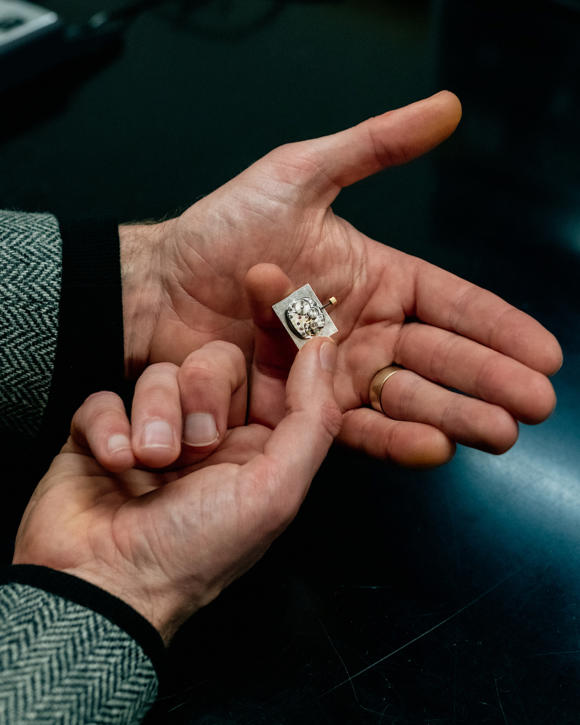
It can be a little galling getting a high-end watch serviced. Given the cost could be between £500 and £1000, it's easy to feel you're spending a lot of money just to get the same thing back again.
Perhaps it's easier to swallow if you've spent 20k of your own money; but it's rather less so if the watch is a fraction of that, or indeed was a gift.
It was nice to witness my Reverso being serviced and repaired at Jaeger-LeCoultre recently, therefore, by the very affable watchmaker in Bond Street.
It gave me a new respect for the work involved, and put the fee in perspective. In fact the whole process seemed closer to making a new watch than having it just checked and tweaked.
As you might expect, throughout I was drawing parallels with menswear - the artisan in the back of the store, the tools and techniques - and I concluded that the best comparison is with a bespoke suit. Like a suit, care and maintenance doesn't make the thing look better (unlike shoes, say) but it is what the piece of fine craft deserves, and it also brings you closer to it - making you re-evaluate and value your possession.
There are a few things that go wrong with watches over the years, but some of the main ones are oils drying, screws failing and water damage.
The first two are so common that they're part of the standard service procedure - cleaning and oiling, replacing all screws. The watchmaker gets a blister pack that contains all the likely required parts, and it's a surprising amount. The mainspring is also replaced by default.
First though, the entire watch has to be taken apart, starting with the case and then working inwards. The pieces are placed in a segmented plastic tray, and it's important to remember which is the top and bottom: because of the natural smoothing of the gold, the two ends (horns) won't fit as smoothly against their opposing ends of the case.
When the front of the case has been removed and the whole movement taken apart, the balance spring and balance wheel are then put back in.
This is so the watchmaker can check how they’re running, and in my case finding that the spring was a little bent (one of the possible reasons it was running slow).
The incredible thing to me is that he then unbends it with a pair of tweezers. How this can be done precisely enough, on such a tiny spring, I don’t know. Most of the realignment is done at this stage, then there’s some fine tuning when the watch is put back together.
This stage uses a finer pair of tweezers than the ones used to deconstruct the watch. The points are so fine that they would apparently snap if used to remove the jewels. Each time he uses them, the watchmaker also sticks them in something that looks like Blu-Tac. Apparently it’s Rodico, which doesn’t lubricate them (as I thought) but removes tiny bits of dust.
It’s harder for Robert the watchmaker to work in this space - in the back of the Old Bond Street atelier - than in the main repair centre, which is in north London.
That larger space has a ‘positive pressure’ system, where filtered air is blown in through the roof, creating pressure that pushes air out whenever someone opens a door - so it’s much harder for dust to come in. In Bond Street there is no such system, and there are more random people (such as us) coming in and out.
When Robert took the hands off my Reverso (top image above), it was clear the watch had become magnetised because one hand immediately jumped up and stood vertically off the face.
The problem with the parts being magnetised is that they become attracted to other parts of the movement. The balance spring, for example, may be attracted to one part but repelled by another, making its rotation less smooth.
Another is a stray drop of oil, perhaps sticking two loops of the spring together. Some parts of the watch are put in a treatment liquid as part of the repair process, to give them greater surface tension and make sure oils stay stuck.
Magnetisation can happen fairly easily, through prolonged contact with the speaker of a mobile phone for example. Fortunately it’s an easy thing to remove: the watchmaker just places it on a small black box (above), presses a button and it’s done. It's also something anyone can walk into the JLC boutique and ask to be checked.
According to Robert, little Reversos like mine are some of the hardest movements of this type to repair - there’s little room for error and they can be unpredictable. Colleagues of his that have worked on far more say sometimes a service can take a few hours, sometimes days.
I have to say, it was really nice seeing the movement of mine taken out and being able to hold it. It’s such an exquisite thing - and all finished beautifully, even though it’s never seen.
In a way, it’s a shame the watch doesn’t have an open back, so that could be appreciated. But of course that would take away from a fundamental aspect of the Reverso - that it can be flipped around so the back faces outwards. I’ve actually thought about ways to decorate that over the years, but have never taken the plunge. Maybe some other day.
After the deconstruction, testing the balance spring and a few other checks, the trays containing the parts are all placed into a desktop washing machine - which uses a nasty ammonia substance to cleanse (below).
That takes a few hours, including two rounds of drying, and then the watch is put back together with oil being added throughout, and each stage tested again. Further parts are replaced, and all the new screws are put in. I also had the crown replaced, the hands (they had become a little oxidised) and the crystal. As I said, it felt closer to building a new watch than just servicing.
The standard service fee of £570 included all these things, and polishing, but the new crystal cost £230.
I have to say I always found watch boutiques a little intimidating, or perhaps just off-putting. It’s probably that sparse, shiny look of luxury retail, plus the security guard.
But this experience, together with my one at Omega recently, have warmed me up. It’s a mixture of the service and the people: everyone at Jaeger was genuine and knowledgeable, unlike the vast majority of fashion boutiques, and advice seemed to be considered part of the benefit of ownership (try going into most big brands and asking about repairs).
Plus it’s nice to know there’s someone like Robert in the back of the store, beavering away, cracking jokes and chasing a misbehaving screw across the worktop.
Thank you Franck, Laurene, Stefania, Robert and everyone else at JLC for taking the time to explain everything to Alex and myself, watch naifs that we are.
Most JLC customers are not permitted to see watch services in progress, and a lot of servicing is done in the separate, larger location. But hopefully this piece gives some insight into the work that goes into it.
My Reverso is yellow gold, ref 250.140.862, from 1997. I bought it second hand 12 years ago. The clothes pictured are:
- Grey herringbone tweed jacket, The Anthology
- Black ‘Dartmoor’ polo knit, Permanent Style
- Dark-brown Drapers 4-ply trousers, Paolo Martorano
- Black ‘Utah’ leather Piccadilly loafers, Edward Green


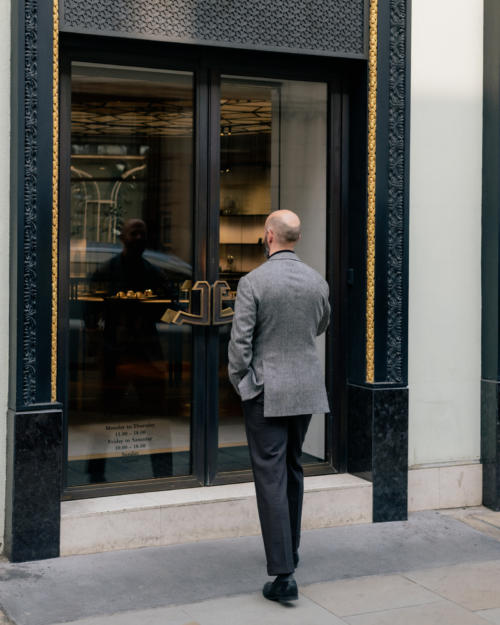

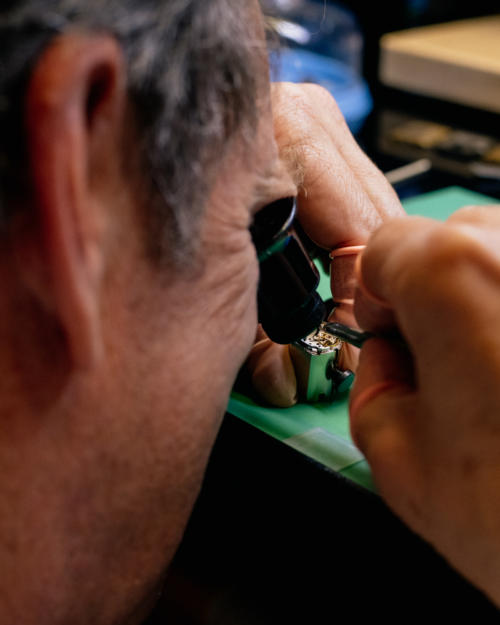
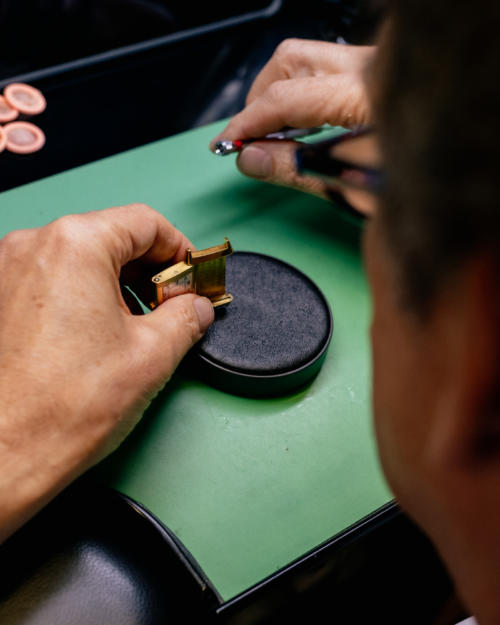
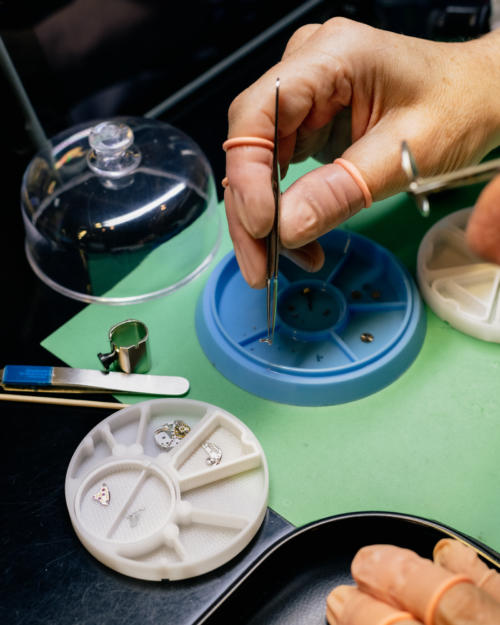
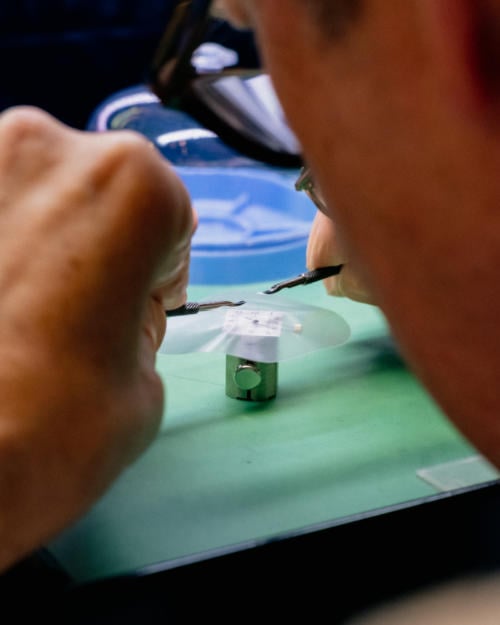
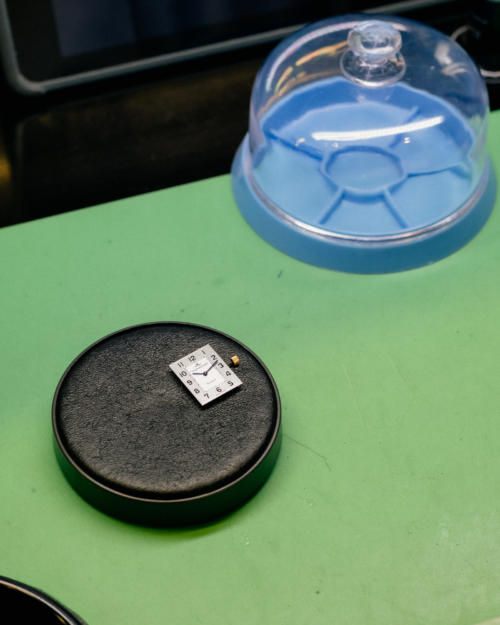
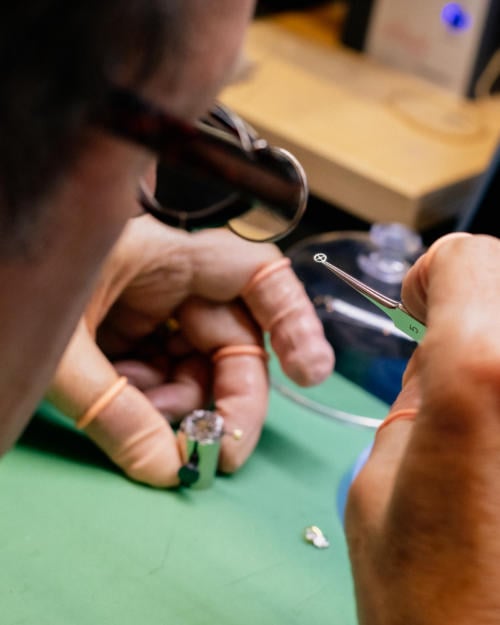
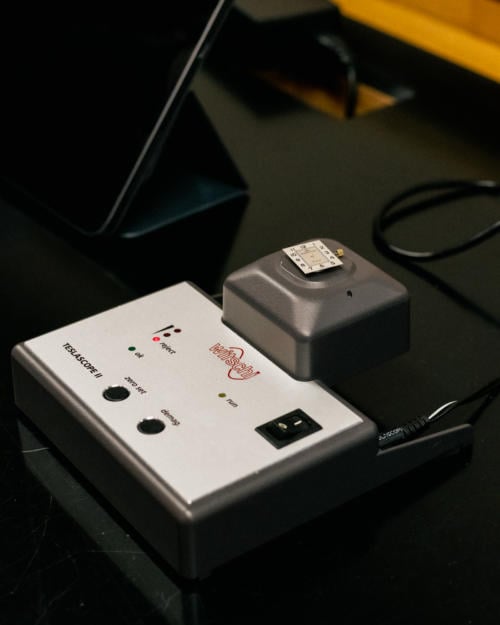

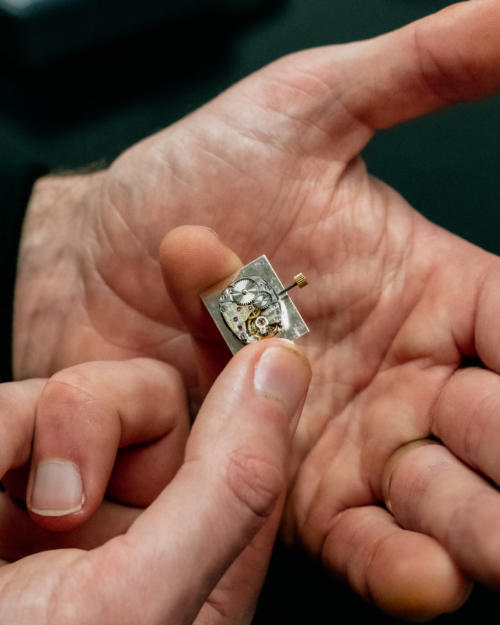

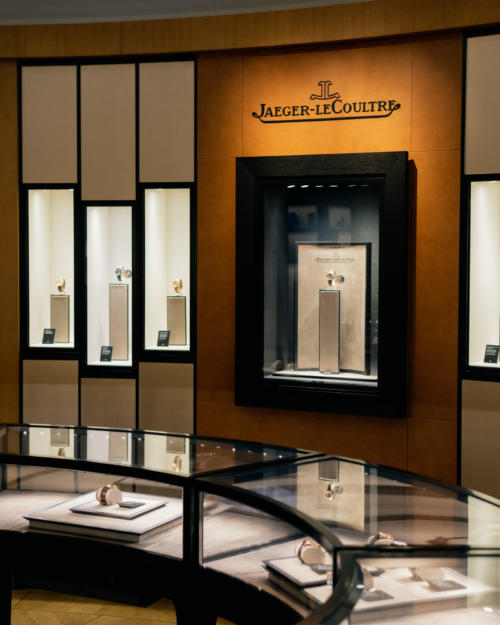
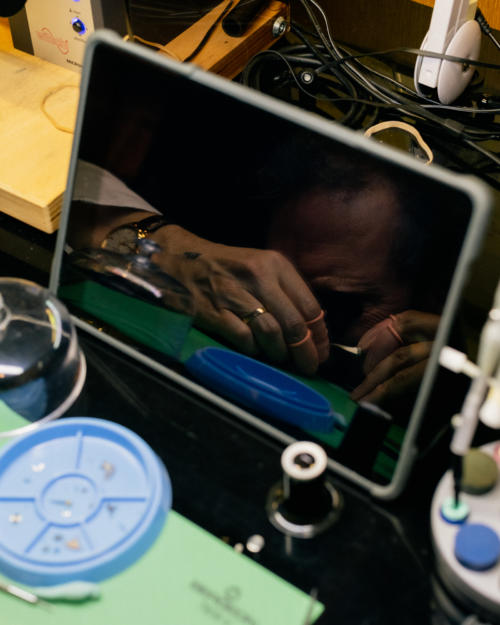
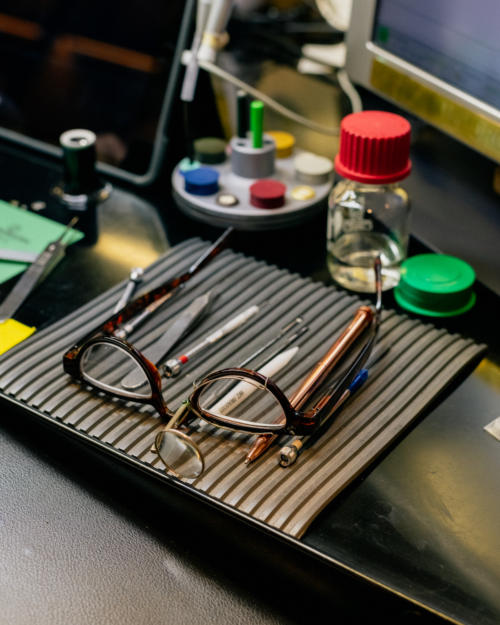
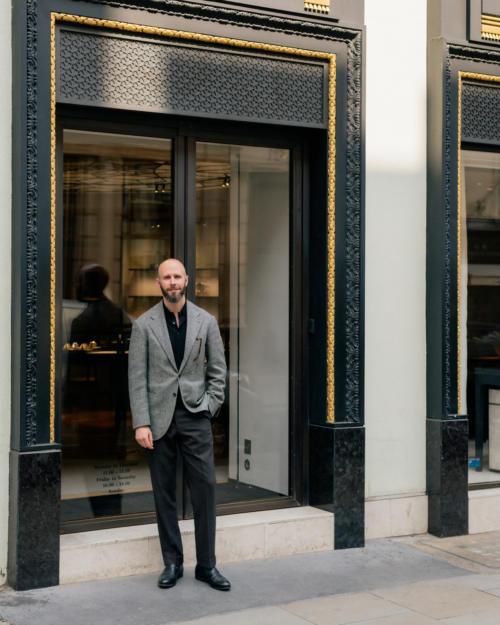


























I have a Bucherer watch that I bought in Zermatt in 2012 and still in great condition. I had to have the accuracy checked in their store in Basel a few years later and I was ushered to their repair shop on the top floor and the equipment used is rather sophisticated as is the excellent service which was free.
The lizard strap though is now broken and dozed and needing replacing but not at Bucherer. The stitching was very poor.
I may go for Ostrich for something different but sturdier.
Any good recommendations for watch strap ateliers?
I use Jean Rousseau – they’re not cheap but they’ve always been good
Many thanks
Jean Rousseau seems really overpriced for what is essentially run-of-the-mill machine-sewn stuff. I’d much rather go to someone like Sergey (@tightly_stitched) or Chester Mox personally.
Thank you David. You certainly pay more for the fact there’s a shop in Mayfair, but I like being able to go in there and take my watch, comparing it against the different shades of colours. And with alligator, picking out which part of the scales you prefer. Less of an issue if you were just going with a black strap I guess
Fair points, Simon, as ever, but isn’t it a bit like going for RTW suits over bespoke just because it’s easier to see how the fabric looks made up? I can see how that would make sense given that RTW is generally cheaper, but in the present case you have an industrial product that’s actually more expensive than what a legitimate craftsman would offer — and surely they’d let you pick whichever part of the skin you prefer if you asked.
Thanks David. No I wouldn’t say so – the difference between the two products is small, certainly a lot smaller than RTW vs bespoke; we’re only talking about a little hand stitching. I wouldn’t call the Rousseau product industrial either, it’s being made at small scale and often on site in the London shop.
I’m sure other makers would let you pick a part of a skin too, but it’s a lot easier to do that in person than remotely and digitally
I think there’s more to it than just a little hand stitching — which by the way is much more durable and not just decorative like most hand stitching on a bespoke suit. A good craftsman will also finish the edges better, which is a very time-consuming process as you know, where industrial producers usually take shortcuts. And I’m sure there are a lot of other points which I’m ignorant of.
Anyway I much prefer supporting artisans over that kind of companies. Judging from the number of things they’re selling on their website, I also strongly doubt their products are made on site.
Thanks David, yes aware of the differences.
I didn’t say all the products are made on site by the way
Where is the Sergei Atelier located please?
I used the Strap Tailor to make me a bespoke parallel strap in Ostrich shin for my 1935 Omega T17. Very nice. Pretty much on par with Rousseau prices (possibly a tad cheaper)..
Nice, thanks Chris
I recommend The Strap Tailor: https://thestraptailor.com/. David has made a couple for me and they’ve been great.
Many thanks Dominic ,Eugène & Benoit!!!
Camille Fournet is very good. They are the strap maker for IWC and JLC if I recall.
Good point Eugene, I’ve used them as well
You should try ABP (Atelier du Bracelet Parisien) who make bespoke straps in any which leather you fancy. How about blue Hippo? They have a nice internet site, but I recommend paying them a visit.
There are so many good strap makers around now. Three that are worth a look are
Molequin
Accurate Form
The Strap Tailor.
That was fascinating !
I had no idea what was involved in a watch service and the fact that they practically rebuild the watch is incredible.
Like you say the cost seems almost miserly when you consider what your getting.
I’d love to see more PS articles on watches. Although there are many well established vlogs and blogs on watches I trust PS as a brand to add a more rounded viewpoint.
Great article.
P.S.
how often would such a service be necessary ?
Nice to hear Robin.
Normally every five years is recommended, though it depends a little on the type and age of watch
Curious, is it 5 years for a daily wear watch? What about a watch worn couple times a month for example?
It would vary with use, though some things happen with age too anyway
The less you use it, the more you need to have it serviced frequently. As any engine, it needs to function.
that definetly makes me want to stick to a smartwatch!
Agreed. Without regular use, the oils pool in parts of the movement rather than remain more evenly distributed. This leads to wear due to lack of proper lubrication. The best test for when service is required is when it’s significantly out of regulation and is no longer keeping good time.
This actually isn’t true. Its a myth that by using the watch the lubricant somehow get distributed. The lubricant is designed to stay in the very spot that needs lubrication.If you really want to know the ins and outs of watch repair/servicing etc jI recommend joining the Omega Forum. Despite the name it doesn’t just cover Omega watches. It can be very nerdy but it’s an invaluable resource for anything watch related.
I agree – this is an excellent article and I’d enjoy reading more if it interests you Simon. I got into the world of fine watches first, then my traditional menswear/tailoring interest followed, all around the time you started writing your blog and the two interests have remained, with clothing maybe coming out stronger over the years.
Yes, there is already a lot out there in the way of watch blogs and such, but it’s really nice to read your writing style and viewpoints on the subject Simon. To me, a watch is just another accessory item that fits into a whole look, so I think the subject fits perfectly into the scope of permanent style. More please!
Nice to hear, and will do
My mom serviced for the first time her 25 year old rolex. They changed everything and came back looking amazing. The total was like 650€ maybe 4 years ago
I bought a Rolex Air-King years ago. A service is recommended ded every five years; I’ve stretched this to about every seven. A local high end watchmaker charges $500.00 plus the cost of any new parts which, to date, have only been minor. So, paying out about $85.00 per year to maintain pin point accuracy on a watch worn 24/7 is a bargain in my mind. The watch is a bit dated in appearance but having worn it for 40 years plus it will eventually be passed on. Maintenance money well spent.
I just bought a JLC Reverso Tribute Duo and I love it so much, much more than my Rolex in all honesty. It brings me smiles whenever I look at it, plus it goes under the radar as only those who know, know.
Ben
Simon, have you looked into servicing your Cartier? I have heard that servicing high end quartz movements is expensive, but most worryingly that many watchmakers don’t service them at all.
I have, Cartier have a nice service too, just across the street from JLC, and will service a quartz for less (understandably). I think it’s £430
Grand Seiko high end quartz movements have a service interval of 50 years. Unlike their mechanical movements which have a recommended service interval of just 3 years.
Thank you
This article smacks of sponsorship and feels very corporate. Hope this is not indicative of a direction for PS.
Sorry you feel that way. It wasn’t sponsored and I thought the writing was more personal and non-corporate than much on watches
A very timely article for me, because I just dropped a (much less expensive) watch and cracked the crystal this past weekend. Tile floors in bathrooms are a lot more dangerous than you’d think.
Personally I use independent watch repairers. Many are British Horological Institute trained. A service for my grand seiko cost me £200 recently. Things are being made trickier for the independent repairer now though with parts availability becoming an issue.
Thanks Dan
Simon,
Interesting article but aren’t you concerned about changing the hands and crown affecting the value?
Thanks. Not really, no, I don’t have any intentions of selling it and prices have and I’m sure will vary considerably anyway.
JLC watches don’t tend to attract the kind of anal retentiveness that vintage Rolex or Omega pieces do, and that’s a good thing in my mind. I’ve always had a soft spot for the brand – it was the first “proper” watch I owned and my experience with the service provided in their boutiques and concessions is the same as Simon’s – the people that work there seem to be genuinely enthusiastic about the brand and its heritage, and are very welcoming and willing to educate.
Simon, did you get the watch polished? How do you feel about that? Some watch collectors do not like to get a watch polished because it smoothes out the edges too much and lowers the value of the watch. And some would argue, it takes away from the character of the watch.
No I didn’t actually, not because of the value (I have no intention of selling it, and by the time I ever did it would all be dinged up again) but because I do like the character it has
Polishing is more relevant with stainless steel cases. Gold acquires a “patina”, steel does not.
Yes this type of service is expensive but it reflects a different attitude toward things. Buy quality, maintain and repair is very different than buy cheap and replace often.
Thanks Simon, that was interesting to read and £570 sounds like great value given the expertise involved. I’ve just finished reading “Hands of time” by Rebecca Struthers (PhD) and it’s fascinating insight into the world of watchmaking and includes a story I didn’t know about the birth of Rolex. In other news I’ve picked up my first Barena jacket today – very lightweight relaxed/soft Venetian style and I’m looking forward to wearing it over the warmer days ahead. It marks a change for me to softer lines compared to the more tailored style I’ve been used to.
Sounds nice Rich. I used to like Barena, but the jackets were always a bit too short on me and they didn’t do MTM
Thank you for the feedback about Barena. In my case the sleeves are ideally a little too long but I picked the jacket up in a sale at half price (£260) so will have the sleeves taken up a touch with the money saved! The rest of the fit I’m very happy with.
Nice to hear
I’m more than a little surprised at what sounds like a celebration at things being replaced for being a little oxidised (watch hands). Indeed you have complained of elements on other items being treated to prevent oxidation and lacking patina as a consequence. Why now the change of heart to want to having something look perfect despite its age?
Not being a collector of vintage watches I can only go by what others say but my understanding was generally watches are ultimate devalued by signs of aging (rather than damage) being removed. Whilst I understand you bought these as not new items I doubt you did it as a true investment but it further adds to the confusion as to why you want to remove patina?
There was no noticeable patina on the hands Dan, unlike my GMT where the patina there and the fading on the face make such a difference. Although they were apparently a little oxidised, I couldn’t see it.
In regards to the face, this actually had a very noticeable water spot on it, which it had when I bought it, and which actually lowered the price when I did so. You can see that on the old images. So I quite liked getting that replaced.
It’s also relevant that this is not an old piece, only from 1997, rather different to the GMT from the sixties
I have 2 JLC s and have had both serviced more than once as well as my Rolexes and a Cartier. My local independent has a Rolex trained tech who can also handle a Tudor Pelagos I want to add and the shop has processed the JLCs and a Reverso I want also to add thru the JLC authorized repair as they will do for my Oris and Omega thru those brand’s authorized repairs when needed. I’ve done the Cartier thru their AD. One of the JLCs is a master ultra thin, made on the same line and staff as their complications. I rotate use daily of my mechanicals and use my independents advice of servicing when they don’t function. As to cost it is what it is, the same as my 2020 Land Rover Defender, it comes with the territory. I have a Casio MR-G solar powered that may never need servicing. I don’t know about my RL POLO and Zodiac recently bought. The Lange up/down I’m adding next year will come no doubt with a hefty service premium but may be less than the very high Patek charges. My new Elliot Brown Land Rover watch will only need a battery change. I have a deposit in for a Christopher Ward rhyming watch which may have a more than normal service charge but nothing like the $100K and up repeating watches.
For our 20th anniversary, I gave my wife a JLC Reverso duetto. It has a mother of pearl dial on one side, surrounded by gulloche silver and yellow gold hands, with diamonds above and below the dial, and then a engine turned silver dial on the other side with arabic numerals and blued steel hands – a more traditional Reverso dial.
She, not being a watch person, didn’t quite understand how complicated the movement must be inside the tiny case (it’s a women’s watch, so even smaller than a men’s Reverso only 33mmx20mmx8.5 case). Not only is there the regular movement, it also must function on the opposite side as well. The only downside is that the crown is so small it’s difficult to wind.
Such a beautiful watch.
Hi, for the crown you can get a winder, looks similar to a pin vice,,makes it a lot easier.
I’ve had my Omega cleaned several times over the 20+ years I’ve had it and it has been worth the £200-300 every time. The last time was a complete overhaul-cleaning inside and out and replacing the bracelet after a few pins were bent over the years. It came back like new. I kept the old bracelet as a memento.
Just yesterday, a student came to ask me about it and watches in general so the smartphone generation still see the need for a watch as an investment for yourself or a special gift to someone. All is not lost.
Hi Simon,
I was wondering if you’ve had your Rolex serviced and would you be able to recommend a good place, preferably in and around central London. I know there are lots of places that sell and service them but going on recommendation is always better.
I was quoted approx £500 some years ago for a basic service in more than one Rolex stockist but unfortunately the assistants in the shops that I have spoken to haven’t really instilled much confidence in me, rarely giving me much more information than the price. I appreciate that they are not likely to be the ones servicing the item but nevertheless the first impression sticks.
Many thanks.
I used Steven Hale on South Molton Street and they were good. Understood what I wanted changed and not on my old GMT
Thanks Simon.
Did you keep the old hands and crown, i imagine they would have packaged them for you automatically.
No they didn’t actually, and no I didn’t, but perhaps I should have done
Interesting article. What would also be interesting is reader’s recommendations on independents who can repair and service watches, esp in London. I have a Tag and even for a basic service or battery change it gets posted to an industrial estate in Manchester where you have to wait 6 weeks. Hardly convenient. It has sentimental value even if not financial value.
True Alex, I’m sure some readers will be able to help
Simon, thanks. Very interesting. I totally agree on the fact that high end watch shop are totally intimidating.
A question: I have a Reverso which has never had any check in many years but it works properly. Have you decided for a service to yours for some specific reason or just as periodical routine service ?
No, because it was losing time. You should still have it serviced even if nothing’s wrong, but you don’t have to do it as often
Lovely insight, Simon. Happy to admit, much of the terminology goes straight over my head and yet, seemed to be able to follow exactly what was going on.
I appreciate your point regarding experiences like this bringing you closer to your possesions, the same can be stretched across the board, caring for good leather etc. although admittedly, no where close to as skilled, detailed and precise as this. Look forward to my first ‘proper’ watch, and taking the pleasure in caring for it.
Thank you CK, that’s exactly what I was aiming for! And glad you picked up on that point – I think it’s the opposite of what most people talk about in the watch world, which is being a ‘collector’ of watches.
‘Beavering away’- have not heard that before, but it’s a great analogy. Thank you for the phrase, and the piece.
An international exchange of idioms – lovely. No worries Jay, pleased you liked it
I really like the outfit in the final photo, especially the bottom half. Darker grey high twist trousers combined with black aproned derbies or loafers has been making more and more sense to me recently, especially when you’re out and trying to get something done.
While fairly standard and some might even say boring combination, I think right materials and cut can make it visually exciting while still remaining relatively low profile.
It’s also nice to see how much mileage can be had from that Anthology jacket, it’s quite versatile for these kind of looks.
Thanks, and yes that material in the jacket particularly is so versatile.
I do like that look, as you say – the black and grey manages to look understated but still elegant and not corporate at all
Simon, if you ever have the chance to travel to Switzerland, a visit to the IWC factory in Schaffhausen is well worthwhile. I’ve been there a few years ago.
Thank you Lindsay. The only one I’ve been to is Lange, here, but I would like to visit more